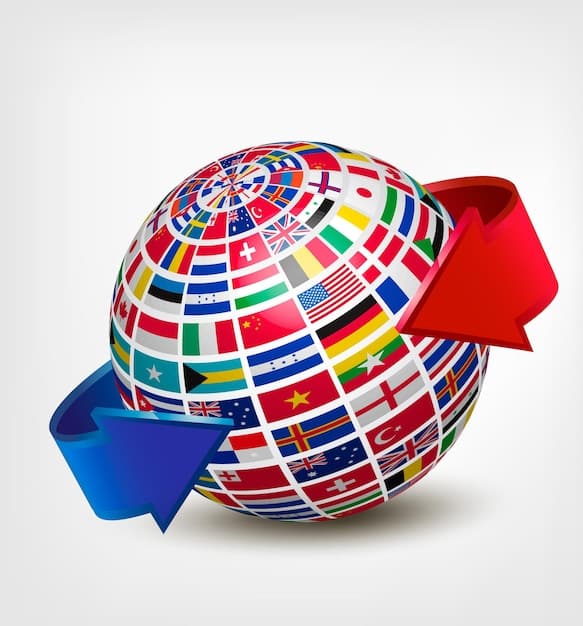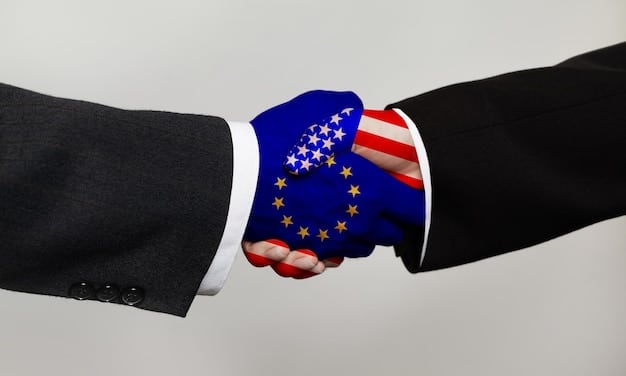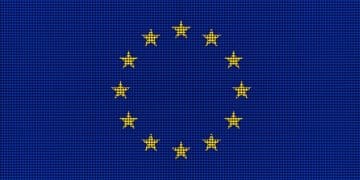US-EU Data Privacy Agreement: Implications for American Citizens

The new US-EU Data Privacy Agreement aims to restore trust in data flows between the United States and the European Union, providing American citizens with enhanced privacy protections and legal recourse regarding their personal data transferred to the US.
The digital age has made data a valuable commodity, and its movement across borders is commonplace. The **implications of the new US-EU Data Privacy Agreement for American citizens** are profound, reshaping how personal data is handled and protected. This agreement seeks to bridge the gap in data protection standards between the US and the EU, aiming to restore trust and facilitate smoother transatlantic data flows.
What is the US-EU Data Privacy Agreement?
The US-EU Data Privacy Agreement, also known as the Trans-Atlantic Data Privacy Framework (TADPF), is a new legal mechanism designed to allow the safe transfer of personal data from the European Union to the United States. It aims to replace the Privacy Shield, which was invalidated by the Court of Justice of the European Union (CJEU) in the Schrems II case.
This agreement seeks to address the concerns raised by the CJEU regarding the adequacy of US data protection laws, particularly concerning access to data by US intelligence agencies. By providing a more robust framework for data protection, the agreement aims to restore legal certainty and facilitate transatlantic commerce.
Key Objectives of the Agreement
The agreement has several key objectives aimed at ensuring adequate protection for personal data transferred between the EU and the US.
- Enhancing Privacy Protections: Strengthening the privacy rights of individuals regarding their data.
- Limiting Access by Intelligence Agencies: Ensuring that US intelligence agencies’ access to data is necessary and proportionate.
- Establishing Redress Mechanisms: Providing individuals with effective mechanisms to seek redress if their data is mishandled.
The Data Privacy Framework introduces binding safeguards to address the concerns raised by the CJEU. These safeguards include limiting access to data by U.S. intelligence authorities to what is necessary and proportionate to protect national security, and establishing an independent Data Protection Review Court to investigate and resolve complaints from EU citizens.
How Does the Agreement Affect American Citizens?
While the primary focus of the US-EU Data Privacy Agreement is to protect the data of EU citizens, it also has significant implications for American citizens. These implications arise from the broader changes in data protection practices and legal standards that the agreement promotes.
The agreement can indirectly affect American citizens by promoting a more robust data protection environment within the US. As companies align their practices to meet the standards of the agreement, American citizens may also benefit from increased privacy and security in how their data is handled.

Increased Data Protection Standards
One of the key implications for American citizens is the potential for increased data protection standards within the US. As companies adopt practices aligned with the Data Privacy Framework, they may extend these practices to all their users, regardless of their nationality.
This could mean that American citizens benefit from stronger privacy policies, greater transparency in data processing, and enhanced security measures to protect their personal information from unauthorized access or misuse. This can lead to increased trust and confidence in online services and platforms.
What Rights Do American Citizens Have Under the Agreement?
While the agreement primarily grants rights to EU citizens, American citizens also have certain rights concerning their data if it is transferred to the EU or if they interact with EU-based companies. These rights are often aligned with general data protection principles and consumer protection laws.
American citizens have the right to access their personal data, correct inaccuracies, and request deletion under certain circumstances. They also have the right to object to the processing of their data for direct marketing purposes and to receive information about how their data is being used.
Access, Rectification, and Erasure
American citizens can exercise their rights to access, rectify, and erase their personal data held by organizations subject to the agreement.
- Access: The right to request confirmation as to whether or not personal data concerning them is being processed, and to access such data.
- Rectification: The right to have inaccurate personal data concerning them rectified.
- Erasure: The right to have personal data concerning them erased under certain circumstances, such as when the data is no longer necessary for the purposes for which it was collected.
Companies operating under the Data Privacy Framework are required to provide clear and accessible mechanisms for individuals to exercise these rights. This ensures that American citizens have the ability to control their personal data and protect their privacy.
How Does the Agreement Impact Transatlantic Business?
The US-EU Data Privacy Agreement has significant implications for transatlantic business, as it aims to facilitate the smooth and legal transfer of data between the EU and the US. This is crucial for many businesses that rely on cross-border data flows for their operations.
By providing a clear legal framework for data transfers, the agreement reduces the risk of legal challenges and disruptions to business operations. This can lead to increased investment, innovation, and economic growth on both sides of the Atlantic.

Benefits for Businesses
The agreement offers several benefits for businesses, including increased legal certainty, reduced compliance costs, and enhanced trust with customers.
With the Data Privacy Framework in place, businesses can confidently transfer data between the EU and the US, knowing that they are complying with data protection laws. This can save them significant time and resources that would otherwise be spent on navigating complex legal issues.
What are the Potential Challenges and Criticisms?
Despite its potential benefits, the US-EU Data Privacy Agreement also faces several challenges and criticisms. These include concerns about the effectiveness of its enforcement mechanisms, the scope of access by US intelligence agencies, and the potential for legal challenges.
Some critics argue that the agreement does not go far enough in addressing the concerns raised by the CJEU in the Schrems II case. They contend that the safeguards for limiting access by US intelligence agencies may not be sufficient to meet the requirements of EU law.
Ongoing Legal Scrutiny
The agreement is subject to ongoing legal scrutiny and could face challenges in the future. This could create uncertainty for businesses and individuals who rely on the agreement for data transfers.
Organizations and privacy advocates may bring legal challenges to the agreement, arguing that it does not provide adequate protection for personal data. These challenges could lead to further revisions or even invalidation of the agreement, as happened with the Privacy Shield.
What is the Future of Data Privacy Between the US and EU?
The future of data privacy between the US and EU is likely to be shaped by ongoing technological developments, evolving legal standards, and changing societal attitudes towards data protection. The US-EU Data Privacy Agreement represents an important step towards a more harmonized and secure transatlantic data ecosystem.
As technology continues to evolve, new challenges and opportunities will emerge in the area of data privacy. It is important for policymakers, businesses, and individuals to stay informed about these developments and to work together to ensure that data is handled responsibly and ethically.
| Key Point | Brief Description |
|---|---|
| 🛡️ Enhanced Privacy | Stronger data protection for EU citizens in the US. |
| 💼 Business Benefits | Legal data transfers, reduced compliance costs. |
| ⚖️ Legal Scrutiny | Face challenges due to data access concerns. |
| 🌍 Global Standards | Sets a precedent for international data protection. |
Frequently Asked Questions
▼
The primary aim is to enable secure and legal data transfers between the EU and the US, providing a framework that protects personal data and facilitates transatlantic commerce.
▼
It introduces enhanced protections, including limiting access by US intelligence agencies and creating an independent Data Protection Review Court for EU citizens’ complaints.
▼
EU citizens can access, correct, and request deletion of their data. They also have the right to seek redress if their data is mishandled by US companies.
▼
It provides legal certainty and reduces compliance costs for US businesses by offering a standardized framework for data transfers, fostering trust with EU customers.
▼
The agreement may face legal challenges regarding the scope of access by US intelligence agencies and its effectiveness in protecting personal data, leading to further revisions.
Conclusion
The US-EU Data Privacy Agreement represents a significant effort to bridge differing data protection standards and facilitate transatlantic data flows. While it offers numerous benefits, it also faces potential challenges that will need to be addressed to ensure its long-term viability and effectiveness.





